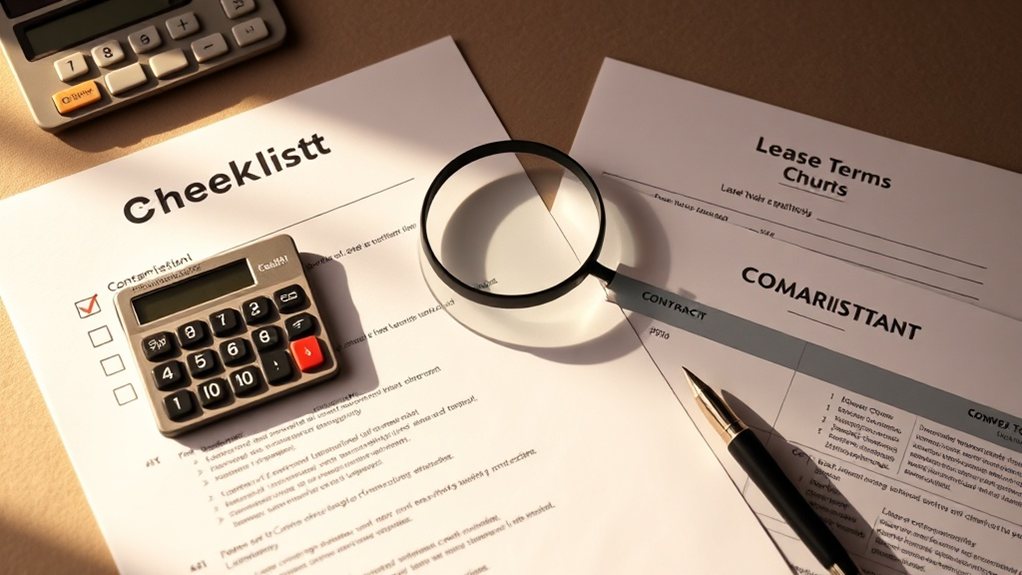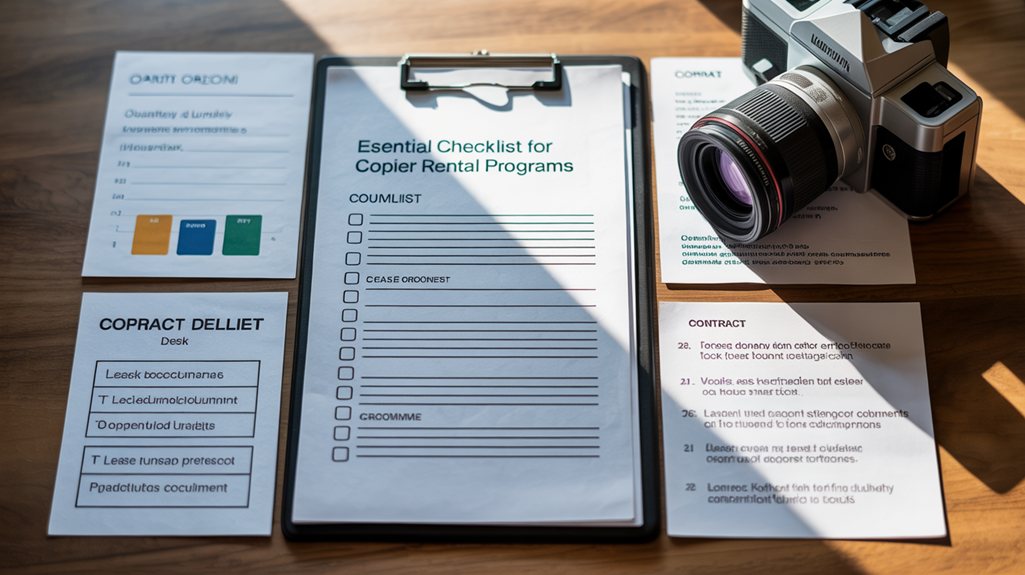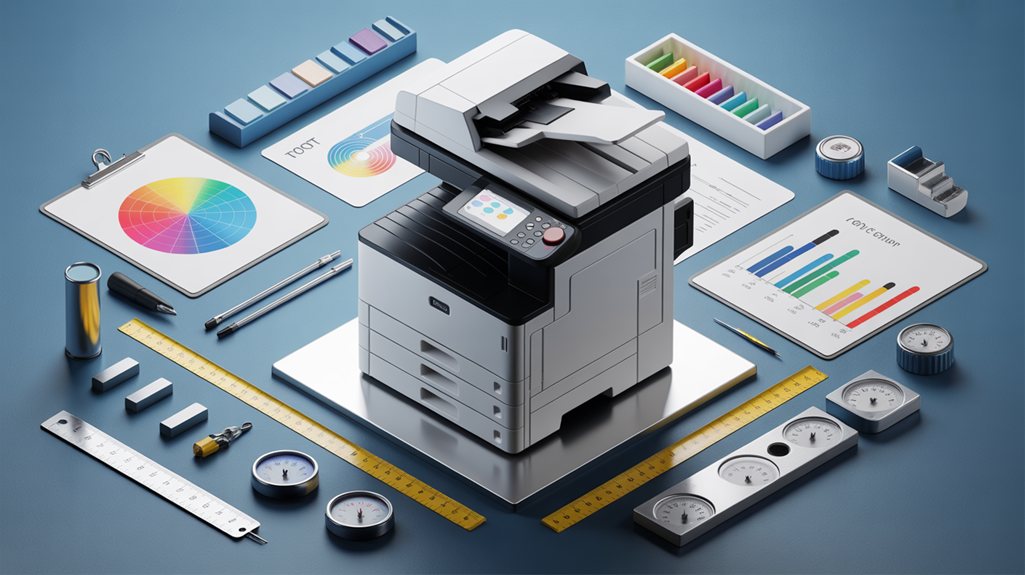
Essential Checklist for Evaluating Copier Rental Programs
A meticulously composed flat-lay arrangement featuring a pristine checklist document, calculator with gleaming keys, magnifying glass revealing fine print, contract pages with crisp shadows, lease terms highlighted by golden light, comparison charts with sharp focus, and a pen positioned strategically. Shot on premium DSLR with shallow depth of field, warm studio lighting casts dramatic shadows across the neutral backdrop, creating professional urgency and analytical precision. –v 6 –ar 16:9
Essential Checklist for Evaluating Copier Rental Programs
Evaluating a copier rental program requires examining nine critical dimensions: monthly fees and hidden costs, contract flexibility with early-exit options, equipment specifications matching actual workflow demands, color versus monochrome capabilities, data security compliance like HIPAA protocols, emergency repair response times, lease type structures, renewal negotiation terms, and five-year total cost projections. Misalignment in any area creates unexpected expenses, operational bottlenecks, or security vulnerabilities. The most effective approach combines detailed itemized quotes, transparent service agreements, and ROI calculations against current systems. Understanding these elements positions organizations to secure genuinely competitive offers rather than discovering costly surprises mid-lease.
Expert Highlights
- Request itemized quotes detailing all monthly fees, supply costs, overage charges, and maintenance to prevent unexpected expenses.
- Verify equipment specifications match actual workflow demands, including speed, volume capacity, and color versus monochrome requirements.
- Negotiate lease terms with flexible exit options, early termination clauses, and month-to-month provisions after initial commitment periods.
- Confirm data security compliance through hard drive encryption, automatic deletion, HIPAA/SOC 2 adherence, and access controls.
- Evaluate Service Level Agreements specifying response times, preventive maintenance schedules, parts and labor coverage, and emergency support availability.
Analyzing Monthly Fees and Hidden Costs

When evaluating copier rental programs, the monthly fee structure often presents the first challenge that businesses encounter, yet this initial cost rarely tells the complete financial story. Beyond base rental rates, companies frequently encounter additional charges for maintenance, toner, paper supplies, and usage overages that can dramatically inflate expenses. A copier quoted at $300 monthly might cost $500 with hidden fees included.
The solution involves requesting itemized quotes breaking down every potential charge and clarifying what services are included. Businesses should ask about per-page costs, overage penalties, and service response times. Understanding these specifics prevents unexpected budget impacts and allows accurate cost comparisons between providers. This transparency enables organizations to identify genuinely competitive offers and avoid financial surprises throughout the rental period.
Understanding Lease Terms and Contract Duration

When selecting a copier rental program, organizations must align lease duration with their operational needs and growth projections, since committing to a three-year contract during a period of expansion or restructuring can create significant financial constraints and operational inflexibility. Early termination clauses become critical negotiation points, as many standard agreements impose substantial penalties that can cost thousands of dollars if business circumstances change unexpectedly, whereas flexible terms with reasonable exit options provide the breathing room necessary for companies to adapt without excessive financial burden. Understanding these lease parameters upfront—including what happens if equipment needs increase, decrease, or if the organization relocates—directly impacts both budget predictability and the company’s ability to respond to market demands without being locked into an unsuitable arrangement.
Duration Alignment With Operations
Most organizations face a critical mismatch between their equipment needs and the lease terms they actually commit to, creating either costly overages or premature contract exits. Aligning lease duration with operational requirements prevents financial waste and service disruptions.
Organizations should consider:
- Peak usage cycles – Identify when printing demands surge seasonally or project-based, guaranteeing lease length covers these high-volume periods without forcing early termination or costly extensions.
- Technology refresh rates – Equipment becomes outdated every three to five years; matching lease terms to replacement cycles averts being locked into obsolete machines that drain productivity.
- Organizational growth projections – Lease duration should accommodate anticipated expansion, preventing constraints that require renegotiation or abandonment before natural contract completion.
Strategic alignment between lease duration and operational demands secures consistent access to appropriate equipment while eliminating unnecessary expenses.
Early Termination and Flexibility
Even carefully planned lease durations sometimes clash with unexpected business realities—sudden downturns, department closures, or technology pivots—leaving organizations trapped in contracts that no longer serve their needs. Standard rental agreements often impose steep penalties for early exit, potentially costing thousands in fees that drain already-stressed budgets.
Smart organizations solve this problem by negotiating flexible termination clauses upfront. Requesting provisions that allow penalty-free exits after 12-18 months, or negotiating reduced early-termination fees tied to remaining contract value, protects against unforeseen circumstances. Some providers offer month-to-month options after an initial commitment period, providing genuine operational flexibility.
These flexible terms deliver substantial value: they eliminate financial risk from market changes, enable swift equipment upgrades when business needs evolve, and reduce the stress of rigid long-term commitments that may become obsolete.
Evaluating Equipment Specifications and Performance

When selecting a copier rental, organizations must evaluate both speed (measured in pages per minute) and volume capacity to match their actual workflow demands, since undersized equipment creates bottlenecks while oversized machines waste rental dollars on unused capabilities. The choice between color and monochrome systems represents another critical specification, as color copiers handle marketing materials and presentations more effectively but carry markedly higher rental and supply costs compared to monochrome alternatives that excel at text-heavy document production. By analyzing monthly page volumes, document types, and budget constraints upfront, businesses can identify equipment specifications that deliver genuine performance value rather than paying for unnecessary features or suffering productivity losses from insufficient capacity.
Speed and Volume Capacity
The engine of any copier rental decision rests on understanding how quickly a machine processes pages and how many copies it can handle without breaking down—two interconnected factors that directly impact daily operations and long-term costs.
Organizations face a critical challenge: selecting equipment that matches actual workflow demands. Insufficient speed creates bottlenecks, while inadequate volume capacity leads to frequent breakdowns and service interruptions.
Consider these essential metrics:
- Pages per minute (PPM) determines output speed; machines range from 25 to 100+ PPM depending on business needs.
- Monthly duty cycle indicates maximum sustainable volume; exceeding limits causes mechanical stress and premature failure.
- Peak-hour capacity guarantees the copier handles simultaneous user demands without performance degradation.
Matching equipment specifications to documented usage patterns prevents costly overages, reduces downtime, and optimizes rental investments.
Color Versus Monochrome
Beyond speed and volume capacity, organizations must address another foundational specification that reshapes both operational workflow and budget allocation: whether to rent color or monochrome copiers. Color printing demands higher lease costs and increased toner expenses, yet delivers marketing materials and presentations with professional impact. Monochrome systems offer budget-friendly operation suitable for document-heavy environments like legal offices or archives. The decision hinges on actual usage patterns. Organizations printing primarily text-based documents benefit from monochrome efficiency, while those requiring branded materials or color graphics justify color rental investment. Analyzing departmental needs reveals whether color justifies premium pricing or whether monochrome capabilities suffice, directly influencing both equipment selection and long-term financial planning.
Assessing Color Versus Monochrome Capabilities
Most organizations face a critical decision when evaluating copier rental programs: determining whether color printing capabilities justify the additional expense, or if monochrome (black and white) functionality sufficiently meets their operational needs.
Copier rental decisions hinge on justifying color printing costs against monochrome functionality for operational needs.
Assessing this choice requires examining specific business requirements:
- Document type frequency – Marketing materials and client presentations demand color quality, while internal reports function adequately in monochrome, directly affecting cost-benefit calculations.
- Volume and usage patterns – High-volume color printing dramatically increases supply expenses and maintenance costs, whereas occasional color needs may warrant rental upgrades only during peak periods.
- Industry standards – Professional sectors like design and healthcare often require color capabilities for compliance and client communication, making color functionality essential rather than optional.
Organizations should audit their actual printing needs before committing to rental agreements, ensuring alignment between capabilities and budget constraints.
Reviewing Data Security and Compliance Requirements
How can organizations make certain that rented copiers don’t become security vulnerabilities when handling sensitive business information? Data security represents a critical concern, since copiers store document images on internal hard drives, potentially exposing confidential information if not properly managed.
Organizations must evaluate vendor security protocols before committing to rental agreements. Key considerations include encryption standards, data deletion procedures, and compliance certifications.
| Security Feature | Why It Matters |
|---|---|
| Hard drive encryption | Protects stored documents from unauthorized access |
| Automatic data deletion | Removes sensitive information when leases end |
| HIPAA/SOC 2 compliance | Ensures regulatory requirement adherence |
| Access controls | Restricts who can retrieve stored files |
Selecting vendors offering thorough security measures, regular audits, and transparent compliance documentation prevents costly breaches while protecting organizational reputation and client trust.
Examining Maintenance Plans and Service Level Agreements
When equipment breaks down unexpectedly, organizations face disrupted workflows, lost productivity, and frustrated employees—challenges that make maintenance planning essential rather than optional. Extensive maintenance plans protect rental investments while keeping copiers functioning reliably.
Organizations should evaluate these key service components:
- Response time guarantees—Specify how quickly technicians arrive when issues occur, typically within 4-24 hours depending on contract tiers, directly affecting downtime duration.
- Preventive maintenance schedules—Regular inspections and component replacements prevent major failures, extending equipment lifespan and reducing emergency repair costs.
- Parts and labor coverage—Clarify whether agreements include all replacement parts and service calls, eliminating surprise expenses during equipment malfunctions.
Service Level Agreements (SLAs) establish clear expectations about uptime percentages, usually 99-99.5%, ensuring accountability and defining remedies when providers fail to meet commitments.
Clarifying Emergency Repair Procedures and Costs
When a copier breaks down unexpectedly, organizations need to understand how quickly a service technician will arrive and what those emergency repairs will actually cost, since delays can halt productivity and surprise bills can strain budgets. Most rental agreements specify response times ranging from same-day to 24-48 hours depending on the service tier selected, while emergency service charges typically add 15-40% premiums on top of standard maintenance fees or require flat emergency call rates. Clarifying these procedures upfront—such as whether after-hours repairs are included, how response times vary by location, and exactly which situations qualify as emergencies—prevents frustration and allows businesses to budget accurately while maintaining operational continuity.
Response Time and Availability
Equipment downtime creates significant operational disruptions and financial losses for businesses relying on copiers, yet many organizations fail to clarify emergency repair procedures and associated costs before signing rental agreements. Understanding response time commitments becomes essential for maintaining productivity.
Organizations should evaluate three critical factors:
- Response time guarantees – Confirm whether providers commit to same-day or next-business-day service, as delays directly impact workflow and employee efficiency.
- Availability during off-hours – Determine if emergency support extends beyond standard business hours, preventing weekend or evening production crises from becoming costly disasters.
- Cost transparency for rush repairs – Establish whether emergency service calls incur additional fees beyond base rental costs, eliminating budget surprises.
Prioritizing these details protects businesses from unexpected expenses and operational paralysis, ensuring copier reliability aligns with organizational demands.
Emergency Service Cost Structure
Beyond guaranteeing quick repairs, organizations must understand exactly how emergency services translate into actual expenses, since hidden fees and unclear pricing structures can transform a minor equipment failure into a budget-breaking incident. Many rental agreements bury after-hours charges, weekend premiums, and diagnostic fees in fine print, leaving businesses vulnerable to surprise invoices.
Organizations should request detailed emergency service pricing before signing contracts. Clarify what constitutes an emergency, which repairs qualify for expedited response, and whether after-hours calls include flat fees or hourly rates. Ask whether diagnostic charges apply separately or roll into repair costs. Transparent pricing prevents financial surprises, enables accurate budgeting, and helps companies compare rental programs fairly. Vendors offering straightforward emergency cost structures demonstrate reliability and build stronger client relationships.
Comparing Lease Type Options for Your Business
Selecting the right lease structure represents one of the most consequential decisions a business makes when acquiring office equipment, since different lease types carry vastly different financial implications, flexibility constraints, and long-term cost consequences. Businesses often struggle distinguishing between operational and capital leases, each presenting distinct advantages and drawbacks that affect budgets and balance sheets differently.
- Operational leases offer lower monthly payments and flexible upgrade options, ideal for companies anticipating technology changes or seasonal demands
- Capital leases provide ownership-like benefits and potential tax advantages, though requiring larger commitments and ongoing maintenance responsibility
- Lease-to-own programs bridge both approaches, allowing businesses to move toward equipment ownership while maintaining payment flexibility
Understanding these distinctions enables organizations to align lease choices with operational needs, cash flow capabilities, and strategic growth objectives, ultimately preventing costly misalignments between equipment solutions and business requirements.
Negotiating Contract Terms and Renewal Conditions
Once a business settles on the appropriate lease structure, the focus must shift toward the specific terms embedded within the contract itself, because the lease type alone does not determine whether a company receives fair pricing, maintains flexibility, or avoids unexpected expenses when renewal time arrives. Businesses often overlook critical contract details, resulting in unfavorable terms that cost thousands annually.
| Contract Element | Common Problem | Solution |
|---|---|---|
| Automatic Renewal | Locks in outdated rates | Request 60-day opt-out clauses |
| Usage Limits | Overage fees surprise budgets | Negotiate unlimited monthly pages |
| Equipment Upgrades | Outdated technology remains | Include free upgrades provision |
Negotiating specific renewal conditions prevents costly surprises. Requesting written approval for any rate increases and clarifying maintenance responsibilities safeguards long-term interests. These deliberate steps guarantee contracts serve business needs rather than vendor preferences.
Establishing Long-Term Cost Projections and ROI
Three critical factors shape whether a copier rental ultimately delivers financial value or drains company resources: the baseline monthly expense, the trajectory of those costs over time, and the measurable productivity gains the equipment provides.
- Calculate total five-year expenses by documenting monthly rental fees, supply costs, and service charges to reveal true financial commitments beyond initial quotes.
- Project usage patterns and efficiency improvements by tracking how new equipment reduces printing time, minimizes downtime, and streamlines workflows compared to current systems.
- Compare rental ROI against equipment purchase scenarios by analyzing break-even points, maintenance obligations, and technology obsolescence risks that favor flexible rental agreements.
Organizations establishing these projections gain clarity on whether rental investments generate positive returns or represent unnecessary overhead, enabling confident budget decisions aligned with operational realities.
Frequently Asked Questions
What Happens to My Leased Copier if My Business Relocates or Downsizes Unexpectedly?
When a business relocates or downsizes, lease agreements typically allow equipment relocation at no extra charge. However, early termination may incur penalties. Lessees should review their contract terms regarding relocation provisions and potential cancellation fees before signing.
Can I Upgrade to Newer Copier Models Mid-Lease Without Incurring Substantial Penalties or Fees?
Most copier leases permit mid-lease upgrades to newer models, though terms vary considerably by provider. Some agreements offer penalty-free upgrades at scheduled intervals, while others charge modification fees. Reviewing specific lease terms determines actual upgrade costs and flexibility options available.
Are Consumables Like Toner, Paper, and Drums Included in Monthly Rental Fees?
Most copier rental programs include toner, paper, and drum replacements within monthly fees. However, coverage varies by provider and agreement terms. Customers should verify specific inclusions before signing contracts to avoid unexpected expenses.
Who Bears Responsibility for Copier Damage Caused by Normal Wear and Tear Versus Misuse?
Normal wear and tear typically remains the rental company’s responsibility, while the lessee bears responsibility for damage from misuse or negligence. Rental agreements should clearly define these distinctions to prevent disputes.
What Vendor Support Options Exist Outside Standard Business Hours for Urgent Printing Needs?
Vendors typically offer 24/7 emergency hotlines, remote diagnostics, and expedited technician dispatch for after-hours printing crises. Some contracts include guaranteed response times within two hours and loaner equipment provisions during repairs.
Expert Final Thoughts
Selecting the right copier rental program requires systematic evaluation across multiple critical dimensions, from financial structures to security protocols. Organizations that thoroughly assess monthly costs, contract flexibility, equipment capabilities, and repair procedures position themselves to avoid unexpected expenses while maximizing operational efficiency. By comparing lease options and negotiating favorable terms upfront, businesses secure sustainable, cost-effective document management solutions aligned with their specific operational requirements and growth trajectories.